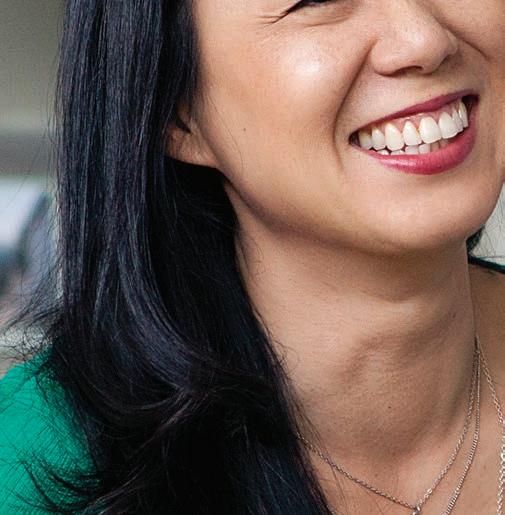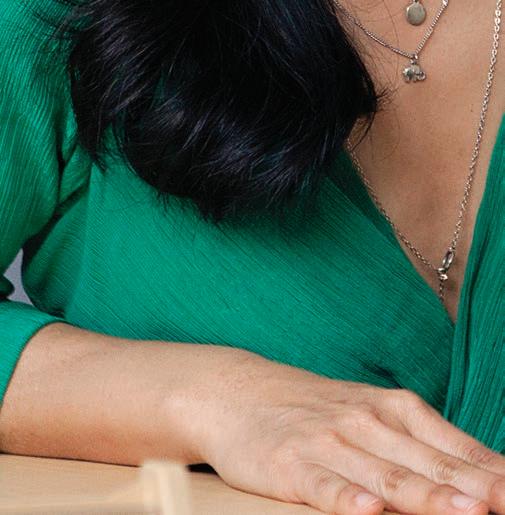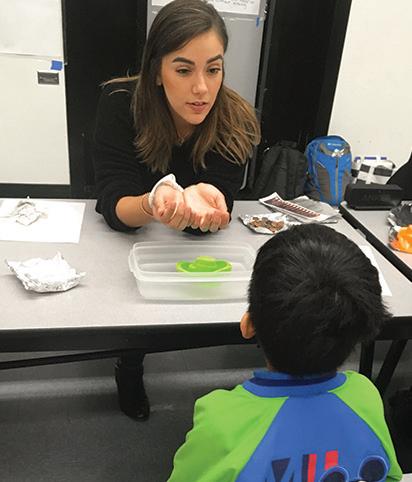
5 minute read
Cathery Yeh’s growing coalition of researchers and educators reimagines the mathematics classroom
+ Cathery Yeh’s growing coalition of researchers and educators builds equity by reimagining the mathematics classroom. –

Advertisement
CHANGING MATH GOOD + + FOR




Cathery Yeh’s excitement is palpable as she addresses the room full of K-12 educators at the Better Together: California Teachers Summit. “We need to move away from fi xing students to fi xing the environment,” Yeh says. “We should be designing math classrooms with the idea that there is no norm. You’re going to have a diverse group. And what we know is that diversity is beautiful.”
Th is keynote speech is just one of the many ways that Yeh, Ph.D. and Chapman University assistant professor in the Attallah College of Education, has advanced the movement to battle inequalities in education. Her primary vehicle for change: math. Why math? “Because mathematics holds power,” Yeh says.
When we think back to our own school days, who do we remember as the smart kids? Most likely they’re the elite few who did the best in math. Yeh points out that high achievement in mathematics sets students on a course for success in academics and in life.
“Math is power. Math carries status,” says Yeh. “We have to shift the way we teach it so every child can see how brilliant they are.”
But Yeh noticed that powerful math experiences were not available to many students, disproportionately leaving out under-resourced communities, non-native English speakers and students with disabilities, for example.
“Schools are more segregated than ever,” says Yeh, who taught elementary, dual-language classrooms in the Los Angeles urban core for 10 years. During that period she made over 300 home visits to immerse herself in the community and engage parents and guardians.
In classrooms, students are oft en assigned labels — high, low, smart, struggling. Th e labels teachers assign to students, Yeh explains, aff ect student achievement more than any other teacher-student interaction factors in education.
To address this inequality, Yeh designed a new math methods course for graduate students in the Attallah College of Educational Studies Teacher Education Program. Th anks to the support of Chapman’s Pedagogical Innovations Grant, the program involves a handson, community-based component taking Chapman students into local K-12 classrooms. Combined with scholarly research done in close collaboration with Yeh, the program is designed for maximum impact. “In traditional math methods courses in teacher education programs, students learn about the math content, children’s mathematics thinking and how to teach—all at the university,” explains Yeh. “Our Chapman graduate students have opportunities to learn how to teach mathematics in school classrooms, with teachers and with groups of students. Th is kind of authentic learning will have a larger impact on our students and in our local schools.”
Th e foundational element of the methods course is designing what Yeh describes as “rich mathematical experiences” that leverage the knowledge base of all students, regardless of background, English language profi ciency or ability status. Th e instruction is grounded in problem solving, reasoning, play, and, what Yeh argues is most important, real-world application. In 2017, the National Council of Teachers of Mathematics (NCTM), the world’s largest math education organization, published Yeh’s book, “Reimagining the Mathematics Classroom.” In it, she conveys the need for changing the way math is taught, building knowledge on what students already know rather than disenfranchising large swaths of students with rote learning that’s disconnected from the real world.
Aft er the book held 18 months on its bestseller list, NCTM asked Yeh to join the writing team of mathematics education leaders to write a new book titled “Catalyzing Change,” due out in April 2020. For this book, Yeh is collaborating with colleagues across three diff erent universities to share research outcomes and provide schools and districts with proven models and methods to put into practice.
Th e math methods course builds on Yeh’s research in special education. She and her coprincipal investigator, Trisha Sugita, Ph.D., received Chapman’s Faculty Opportunity Grant to pioneer and conduct a preliminary evaluation of a technology-facilitated model to improve special education math instruction. Oft en special education teachers are given the district math textbook and told to teach students with a wide range of ability.
“Th e teachers tell me they can’t use the textbook because it doesn’t meet anyone’s needs,” says Yeh.
Th e research team meets monthly with these teachers and co-teach in their classrooms, looking at the existing curriculum and building learning experiences based on the children’s current understanding.
As an illustration, Yeh mentions Jason, 4, from one of these classrooms. One day, his teacher notices that Jason has neatly arranged the peas on his lunch plate in what look like 10 frames, a visual model for learning basic math facts. Jason points to the peas, beaming proudly, and says, “I made a group of 10 and a group of three. And it’s 13.” Th e teacher praises him for showing his math understanding. Th is could be chalked up to just another precocious shareworthy moment, but it’s noteworthy that Jason is diagnosed with autism and ADHD and is in a self-contained special education classroom.
Yeh mentions another child who, for the fi rst time in six years, is adding and subtracting using the tools and methods from this program. “Some of these students classifi ed with a disability are outperforming their mainstream counterparts in math,” Yeh reports. “Classroom instruction shouldn’t be designed to get students to only engage in rote calculations – there are calculators to do that,” says Yeh. “Rote memorization isn’t enough anymore.” Rather, the new generation of math students should be problem solvers, critical thinkers, and active participants in a diverse democracy – ready to use mathematics as a tool to make sense of our world’s pressing problems and create change, she says.
“We need a paradigm shift . Every child can problem solve. How can we support teachers in changing their classroom environment to build on each student’s strengths?”

Graduate student Marissa Fierro demonstrates a STEAM (Science, Technology, Engineering, Art, Math) activity incorporating basic counting skills with explorations on density and mass. The question: How much weight can aluminum-foil boats fl oat?







